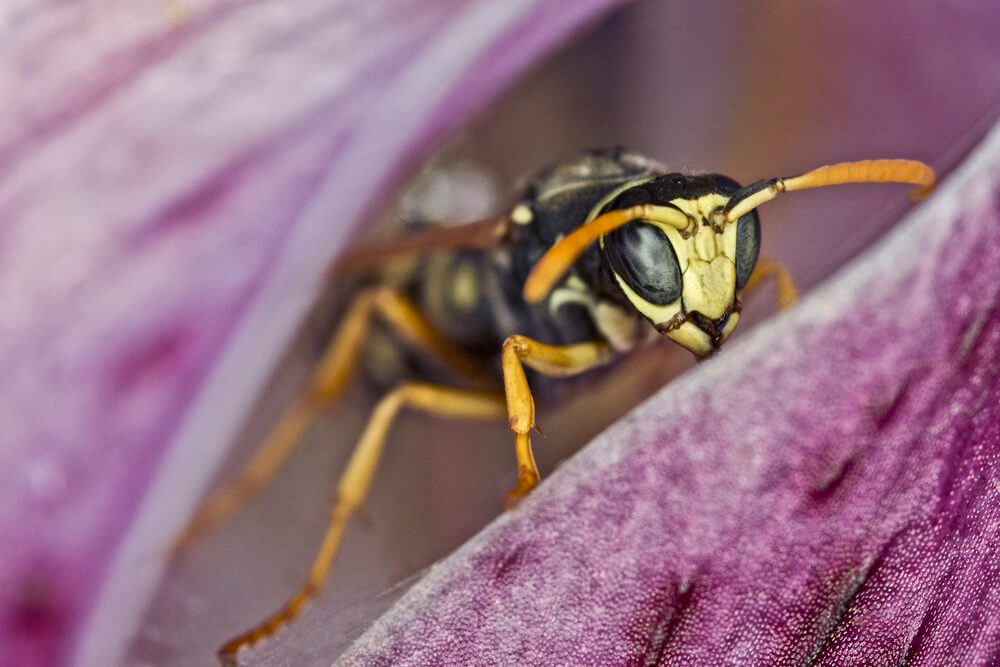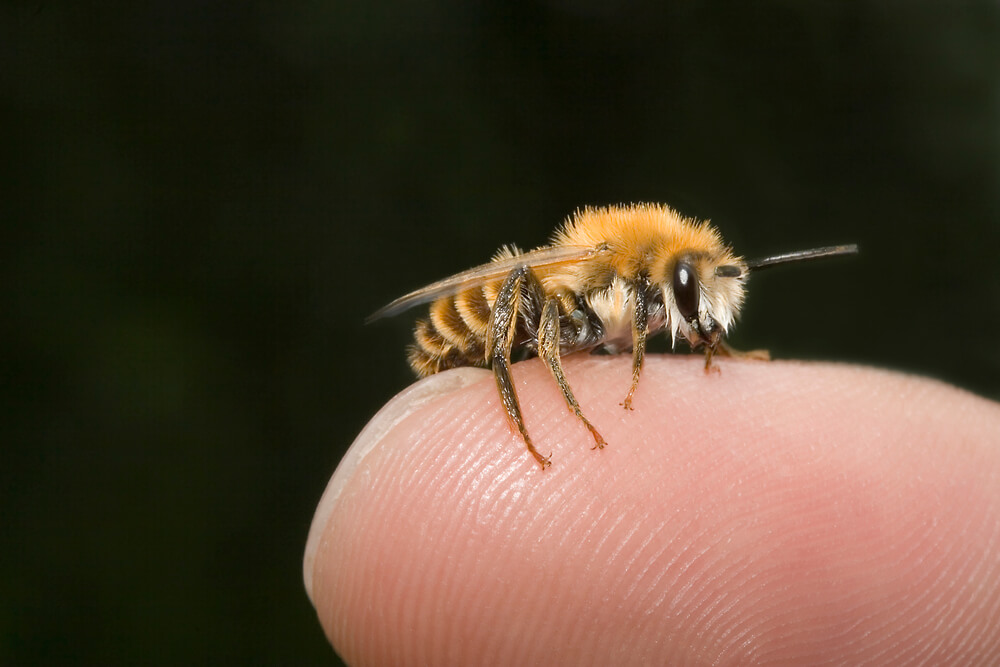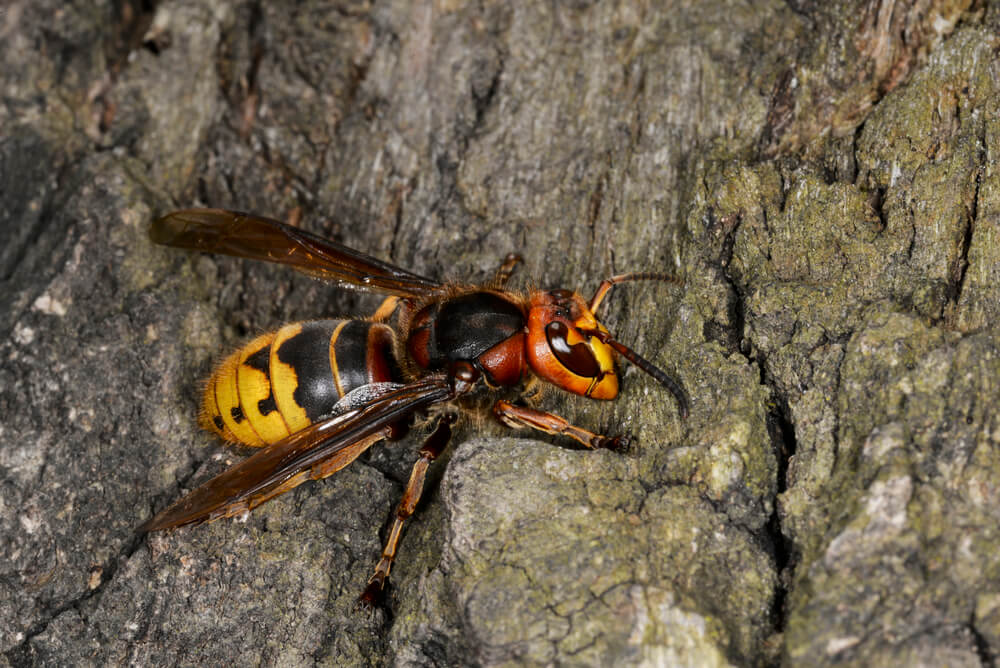In this article:
Do Honey Bees Sting?

Yes, honey bees sting when they feel their hive is in danger.
But now you might be asking:
Well, how often do honey bees sting?
The truth is, honey bees rarely sting when they’re away from their hive.
Simply put, when they’re away from their beehive, they have nothing to protect. So when honey bees are out foraging for food and pollinating flowers, it’s unlikely you’ll get stung.
Sure, they may buzz around you, but honey bees are too busy working to cause harm.
The bottom line?
In most cases, if you leave honey bees alone, they’ll leave you alone. You can just peacefully watch them buzz around.
And in case you’re wondering what a honey bee sting looks like up-close, check it out:
But now here’s a fun fact:
Not all honey bees sting.
In fact, only female honey bees have stingers. Male honey bees – known as drones – don’t have stingers, so they can’t sting you.
The queen bee has a stinger, but she mainly uses it against other rival queen bees. In most cases, the honey bees you see buzzing around are female worker bees – not queen bees or male honey bees (drones).
Now you’re probably wondering…
What Happens to a Honey Bee Once it Stings?
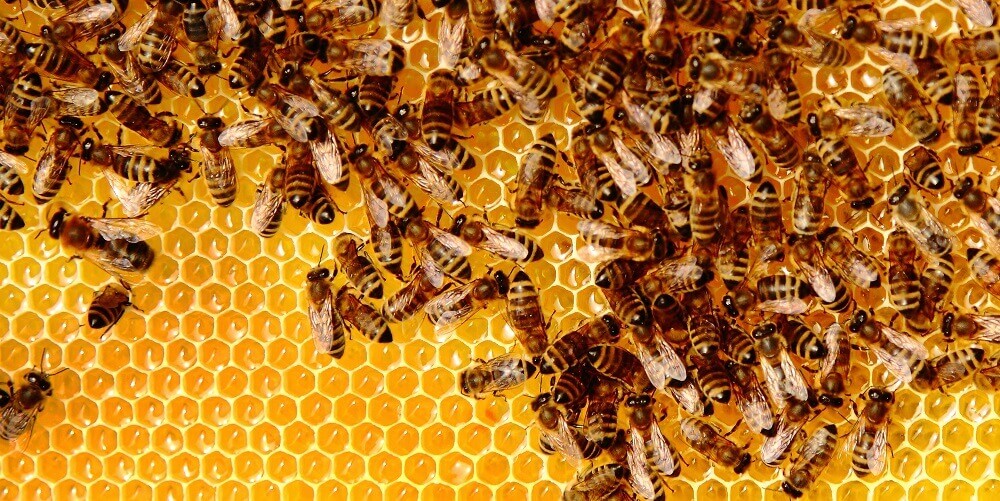
Nothing good.
In a nutshell, the honey bee’s sting is a suicide mission for them. They die within a few minutes after stinging.
How come, you ask?
Because a honey bee’s stinger is attached to its abdomen, digestive tract, muscles, and nerves. Unfortunately, the stinger gets embedded into your skin and once the honeybee flies away, it essentially yanks out her abdominal tissue, aka “guts.”
The only way to avoid this is to give the honey bee a few minutes to gently work her stinger loose. If she can work her way loose, then she can keep her stinger intact.
Related: How to Get Rid of Carpenter Bees
How to Avoid Being Stung by a Honey Bee
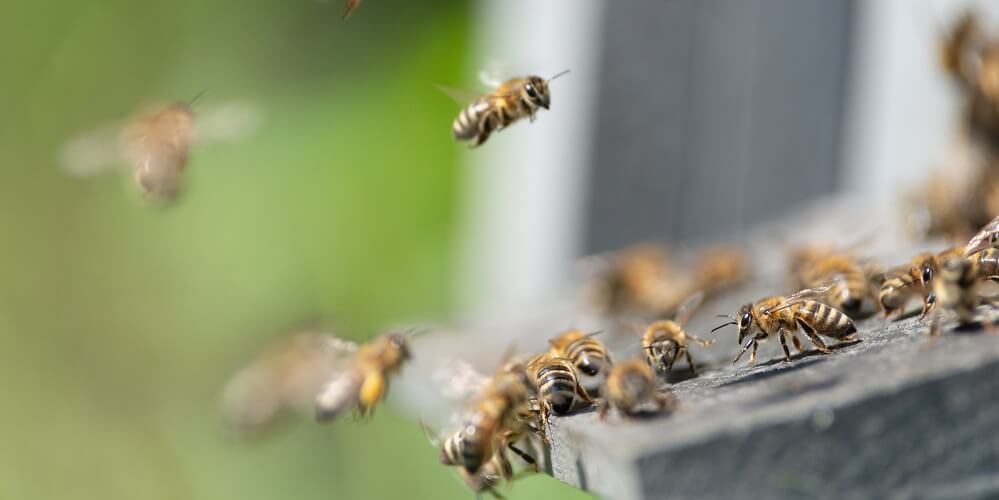
Tip 1: Leave Beehives Alone
This goes without saying, but I couldn’t go without saying it:
Keep your distance from beehives. Never spray chemicals, water, touch, or throw objects at their hives. These things can aggravate the honey bees and put them into defense mode.
And if you’re mowing or gardening around a hive, take proper precautions, such as wearing a bee suit or hat/veil for face protection.
If you discover a honey bee hive in your garden or yard, get help from a local beekeeper. You can search online or contact your local beekeeping association.
Tip 2: Stay Calm
If you see a honey bee buzzing around flowers, it’s because that’s how they collect their food.
The good news?
Bees go about their foraging in peace. They mean no harm, and it’s unlikely that they’ll attack you while they’re away from their hive.
That said, resist the urge to panic or wave your arms around to shoo them away. Just remain calm and move out of their flight path. You can peacefully watch them from a distance.
Tip 3: Wear Light Colored Clothing
Have you ever noticed how most beekeepers wear white?
There’s a reason for that.
Dark colors can put bees into defense mode because many of their natural predators are dark. Think raccoons, bears, and skunks as examples.
So your best bet is to avoid dark clothing if possible. Also, tie your hair back into a bun if it’s long (and especially if it’s dark). Having a honey bee get caught into your hair is no fun.
Tip 4: Avoid Scents That Attract Bees
The best tip I can give you is to think like a bee.
For example, bees are naturally drawn to sweet scents, such as fruity and floral fragrances or foods. You’re less likely to attract honey bees if you avoid these scents when they’re around.
How to Treat a Honey Bee Sting
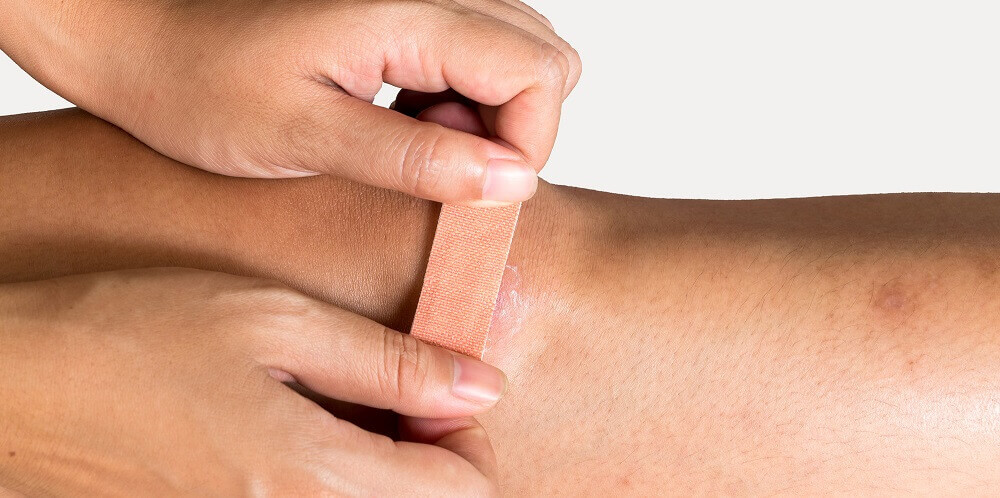
For most people, a bee sting is little more than an annoyance.
You may feel temporary discomfort, swelling, redness, and itching at the sting site for a bit, but then the pain disappears.
That said, bee stings can be more severe for those allergic. Bee stings can even be deadly if you’re not aware of your allergy and react adversely when stung.
Severe allergic reactions may cause:
- hives
- extreme itching
- swelling of the throat or tongue
- trouble breathing
- rapid pulse
- vomiting or nausea
- diarrhea
- dizziness
- faintness
If you discover any of the above symptoms, seek immediate help. You may be having an allergic reaction or a life-threatening anaphylactic shock.
But what about those of us who aren’t allergic to bee stings?
The good news is that we can treat them ourselves. Here’s how to treat a bee sting at home:
Step 1: Remove the stinger
Remove the stinger quickly with the end of your fingernail or tweezers, as this will reduce the venom amount released into your skin.(1)
Step 2: Wash the area
Clean the area with soap and water. The most effective approach to prevent venom absorption is to ice the sting site. It can also reduce swelling.
Step 3: Apply something to help with the inflammation and pain
Thankfully, there are several at-home remedies for treating bee stings.(2)
Here are a few:
Toothpaste
Toothpaste is a simple and inexpensive home treatment to try. Simply dab a tiny amount on the sting and allow it to sit for several hours or overnight.
Baking soda
Baking soda may help neutralize bee venom, reducing pain, itching, and swelling.
Here’s what you do:
Mix baking soda with water to form a paste. Apply the paste to the wound then put a bandage over it. Allow it to sit for at least 15 minutes.
Honey
Honey has been found to assist with wound healing, inflammation, and itching. Apply a small dab of raw and unfiltered honey to the affected region to treat the bee sting. Put a bandage over the sting and leave it on overnight.
Related: Do Carpenter Bees Pollinate?
FAQs about “Do Honey Bees Sting?”
- Do honey bees sting or bite?
- Do all bees sting?
- Do honey bees sting for no reason?
- Do honey bees die after stinging?
- Do honey bees sting birds?
- Do honey bee stings hurt?
- Do honey bees sting beekeepers often?
- How do beekeepers avoid getting stung by honey bees?
- Do honeybees sting at night?
- Is it possible to never get stung by a honeybee?
- Can you make yourself immune to bee stings?
- What happens when a queen bee stings you?
- What should you do if a bee lands on you?
Do honey bees sting or bite?
They can do both.
Honey bees bite insects that aren’t large enough to sting, such as wax moths and parasitic varroa mites. This bite paralyzes the victim, allowing the honey bees to carry the body away from their hive.
And of course, honey bees can sting if they feel threatened.
But as I previously mentioned:
This is rare. When a honey bee is away from the hive foraging, it’ll rarely sting you unless you purposely agitate it. This is true for most types of bees, including the popular bumblebee.
—> Go back to the “Do honey bees sting?” FAQs
More to Explore:
Do all bees sting?
No, only female bees can sting.
So if you’ve ever wondered, “Do male honey bees sting?” the answer is no. Male bees are unable to do so because they don’t have stingers.
You see, stingers are a modified egg-laying device. Since male bees don’t lay eggs, they don’t have stingers. The queen honey bee lays eggs while the female worker bees just use stingers for protection.
Other types of bees sting such as bumblebees, carpenter bees, and Africanized honey bees. See our articles on “Do carpenter bees sting?” and “Do bumble bees sting?” for more examples.
—> Go back to the “Do honey bees sting?” FAQs
More to Explore:
Do honey bees sting for no reason?
No. Bees sting when they feel threatened or need to protect their colony. It’s self-defense for them. A colony being attacked by predators, such as bears or skunks, is an example of this.
—> Go back to the “Do honey bees sting?” FAQs
More to Explore:
Do honey bees die after stinging?
In most cases, yes.
This is a frequent question we get, along with other FAQS like:
Do honey bees sting you? / Do honey bees sting more than once?
Why do honey bees sting if they die?
Why do honey bees sting people? / Will honey bees sting me?
Here’s the deal:
Once a honey bee stings and leaves its stinger behind, they die. Stinging essentially rips out their organs.
The only exception is if a honey bee keeps its stinger.
Check out this video for an example:
—> Go back to the “Do honey bees sting?” FAQs
More to Explore:
Do honey bees sting birds? Do honey bees sting hummingbirds?
Yes, honey bees can – and sometimes will – sting birds. That said, due to their protective feathers and the fact that most birds avoid bees and wasps, they don’t get stung often.
Also, birds fly quickly and can usually escape. This is especially true for hummingbirds – which can reach flight speeds of up to 60 miles per hour in a dive.
And another thing:
When compared to wasps, hornets, and yellow jackets, honey bees are typically less aggressive in the first place. They use stinging as a last resort when their hive is threatened.
But while bees typically don’t sting birds, there are caveats.
For example:
Several species of birds eat bees. In fact, some birds’ diets comprise primarily of bees, such as birds called bee-eaters, summer tanagers, and purple martins.
These birds may become pests to your local honey bees. In this case, honey bees will attempt to sting these birds to protect their hive.
Other birds only eat bees occasionally, either as adult bees or larvae. One species of bird that prefers the larvae of bees is called the honey buzzard.
—> Go back to the “Do honey bees sting?” FAQs
More to Explore:
Do honey bee stings hurt?
Yes, they do. But for most, the pain isn’t unbearable.
Most of the time, bee stings produce only minor symptoms: a burning sensation at the sting site and slight redness. You might also experience some slight swelling around the sting area.
But with that in mind, everyone experiences bee stings differently. It can range from temporary pain and discomfort to a severe allergic reaction that is life-threatening.
Also:
One type of reaction doesn’t necessarily mean you’ll have the same response every time you’re stung. You might have a more mild reaction one time, and a more severe one the next.
Minor bee sting reaction
Most of the time, mild bee sting reactions include:
- Quick, sharp burning pain at the sting site
- Redness and inflammation at the sting area
- Minor swelling around the sting area
For most, the swelling and discomfort disappear within a few hours.
Moderate bee sting reaction
Some individuals who are stung experience a stronger reaction, with symptoms such as:
- Sharp pain that lasts several hours at the sting site
- Extreme redness and inflammation
- Swelling at the sting that slowly enlarges over the next 48 hours
Moderate reactions tend to resolve over a few days.
Severe bee sting reaction
Bee stings can cause a severe allergic reaction (anaphylaxis) that is potentially fatal, and it must be treated immediately. Anaphylaxis, a severe allergic reaction, can develop in a small number of people who are stung by bees.
Signs of anaphylaxis include:
- Severe reactions including hives, itching, and flushed skin
- Trouble breathing
- Swelling and inflammation of throat and tongue
- A rapid pulse
- Vomiting, nausea, or diarrhea
- Faintness or dizziness
If these symptoms happen to you, get medical help immediately.
Multiple bee stings
As previously mentioned, bees typically aren’t aggressive and only sting for protection when they feel threatened.
In most cases, this results in one sting. In some cases, if you disrupt a hive or swarm of bees, you can get stung multiple times. Certain bees — such as Africanized honeybees — are more likely to be aggressive and swarm. This can be very dangerous.
If you get stung several times, all that venom may give you a toxic reaction that makes you feel sick. Symptoms of this include:
- Headache
- Dizziness or a feeling of spinning (vertigo)
- Nausea, vomiting, or diarrhea
- Convulsions
- High fever
- Loss of breath
Several stings can be a medical emergency in animals, children, older adults, and people who have medical conditions such as heart problems.
—> Go back to the “Do honey bees sting?” FAQs
More to Explore:
Do honey bees sting beekeepers often?
It depends.
Beekeepers perform hive inspections which can agitate the honey bees and cause them to sting.
But remember:
Most honeybees aren’t aggressive. They’re protective.
That’s why many beekeepers wear bee suits for protection so they can perform their hive inspections safely. That said, some beekeepers feel comfortable with their hives and only wear a hat and veil for protection. Beekeepers also use bee smokers to calm their honey bees.
—> Go back to the “Do honey bees sting?” FAQs
More to Explore:
How do beekeepers avoid getting stung by honey bees?
Good question. Here are a few ways beekeepers avoid getting stung:
1. They wear protective gear
The amount of protective gear beekeepers use depends on the individual.
For example, some beekeepers wear full bee suits and gloves so they don’t feel any stings. Other beekeepers only wear hats and veils while leaving their hands exposed. It depends on the beekeeper’s comfort level and the temperament of the beehive.
2. They use bee smokers
Smoke calms honey bees by masking their alarm pheromones. Beekeepers use bee smokers to puff smoke onto the hive before inspecting.
3. They don’t walk in front of the hive
If you watch a beekeeper perform a hive inspection, you’ll notice they never block the hive entrance.
Why?
Because the entrance is where honey bees fly in and out of, so they need plenty of space. If a beekeeper is standing in the way, it can agitate the honey bees and cause them to sting. This is why beekeepers work on the sides of the hive.
4. They wait for good weather and timing
Honey bees have a preference for sunny, warm days. This is when they’re out and about foraging for food and working for their hive.
The honey bees aren’t as active on cold, windy, or rainy days, and they prefer to be left alone.
—> Go back to the “Do honey bees sting?” FAQs
More to Explore:
Do honeybees sting at night?
Honeybees will sting if they detect a threat, whether it’s during the day or at night. They usually rest at night, but that won’t prevent the hive from defending their colony against threats.
That said, honeybees will sting less frequently in cold weather since they’ll want to remain inside the beehive as much as possible. Staying clustered together and inside keeps the bees warm.
Despite this, the myth that bees can’t sting at night persists, and I’m sure you’ve heard it.
It’s certainly true that few people are stung by honey bees at night.
But the reason is simple:
You and the bees are more likely to be home at night.
But like I said:
If you try to disturb your bees at night, they’ll defend themselves. However, in areas with cool evening temperatures, the honey bees will frequently remain in their cluster and not come flying at you. This is because their cluster keeps them warm.
So, in this case, it’s the temperature, not the darkness, that keeps them from stinging.
And finally, queen bees are also capable of stinging at night. A queen will often sting a developing virgin queen before or just after she hatches. There are no candles, light bulbs, flashlights, or LEDs in the hive’s deep dark corners to see the queen attack other potential queens, but it does happen.
—> Go back to the “Do honey bees sting?” FAQs
More to Explore:
Is it possible to never get stung by a honeybee?
Sure! I know several people who have never been stung by a bee.
For example, if your exposure to bees is limited, then it’s likely that you’ve never been stung.
—> Go back to the “Do honey bees sting?” FAQs
More to Explore:
Can you make yourself immune to bee stings?
Bee stings are harmful and can even be deadly to individuals who are allergic to bee venom.
However, according to research from Yale School of Medicine, the key toxic component in bee venom — the major allergen — may actually promote immunity and protect against future allergic reactions to the toxin.(3)
Immunity to bee stings can develop fairly quickly in many people. After a few stings over several weeks, the reactions can taper off, the discomfort fades, and the swelling can subside.
But of course, this isn’t true for everyone. If you have a severe allergy to bee stings, you shouldn’t try to get stung to build immunity.
—> Go back to the “Do honey bees sting?” FAQs
More to Explore:
What happens when a queen bee stings you? Do queen honey bees sting?
Since a queen bee’s stinger is smooth, she can sting several times without losing her stinger and dying as a result. This is unlike the fate of a worker bee, which loses her stinger and dies once she stings.
But because of the queen bee’s role in the colony, it’s unlikely that you’ll be stung by her. Her main job is to lay eggs – not defend the hive.
But interestingly enough, a queen bee’s sting isn’t as painful as you might think. This is because her stinger isn’t barbed like the worker bees.
And if anything were going to sting you, it’d be a female worker bee.
—> Go back to the “Do honey bees sting?” FAQs
More to Explore:
- How to Keep Bees Away From Hummingbird Feeders
- Do Bees Have Lungs?
- Wasps vs. Honeybees: How Do They Compare?
What should you do if a bee lands on you?
Relax and do nothing. It’s probably taking a break from flying and will fly away again soon. Don’t jump up and down, flail your arms about, or try to hit it. You’ll cause the bee to get scared and try to defend itself.

